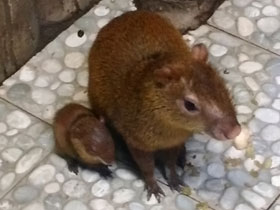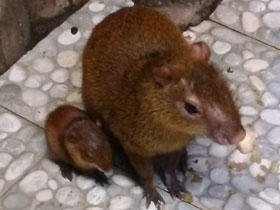Azara's agouti (Dasyprocta azarae)
Azara's agouti видео
Azara's agouti (Dasyprocta azarae) is an agouti species from the family Dasyproctidae. Found in Brazil, Paraguay, and Argentina, it is named after Spanish naturalist Félix de Azara. The population is unknown and may have gone locally extinct in some areas due to hunting; it is listed as vulnerable in Argentina.
Description and features
Dasyprocta azarae is a relative of guinea pigs: it resembles them, but has more elongated limbs. It is also called "South American golden hare" or "humpback hare". An interesting feature is that the agouti has five toes on its front paws and three toes on its hind paws. They are diurnal animals living together in small family groups or pairs, which are created for life. Agoutis devote a lot of time to mutual coat grooming.
Lifestyle and habits
Dasyprocta azarae are excellent swimmers and often settle near bodies of water. They are territorial animals, living in permanent plots, the size of which depends on the characteristics of vegetation within it. These areas are defended from congeners. Dasyprocta azarae are diurnal, and at night they hide in tree hollows or in burrows between roots. In the wild they are fearful and avoid people, but in captivity they become more trusting. In case of danger agoutis tend to freeze motionless, but if the enemy approaches, the animals run away in zigzags, escaping in the nearest shelter. Dasyprocta azarae take food by sitting on their hind legs and holding it in their front legs. Along with capuchins, they are the only animals capable of splitting Brazil nuts - mainly due to their physical strength and exceptionally sharp teeth.
Origin of the species and habitat
Dasyprocta azarae is named after the Spanish travelling naturalist Felix de Azara (1742-1821). Rodents vary in body length from 40 to 64 cm and weigh up to 3-4 kg. The colouration of their fur varies from greenish-brown to greenish-black with speckles of light brown to chestnut colour. The anterior part of the body is yellowish or yellow-brown in colour. Dasyprocta azarae has protruding ears and a rounded body shape. These rodents inhabit the eastern part of South America: they are found in eastern and southeastern Brazil, Paraguay and northern Argentina. Dasyprocta azarae inhabit mainly humid jungles and wetlands, but less frequently they are also found in open pampas, savannahs and cultivated lands. They usually settle near water bodies.
What they feed on
Dasyprocta azarae feed on seeds, nuts, fruits, roots and other plant material, and can sometimes damage banana and sugar cane plantations. Agoutis also stockpile seeds and nuts, thereby helping the spread of plants of certain species, many of which form the basis of rainforests. Often these rodents follow primates, who often drop fruit from trees while eating.
Breeding
Dasyprocta azarae are monogamous; they reach sexual maturity by the end of their first year of life and mate all year round. After a pregnancy lasting 100 to 120 days, the female produces 1 to 4 cubs. In captivity, these large rodents can live up to 20 years.
Dasyprocta azarae is threatened by the uprooting of the humid jungle and intensive hunting for its meat. The species is listed on the IUCN Red List of Threatened Species, but insufficient data are available to determine its status.

















































